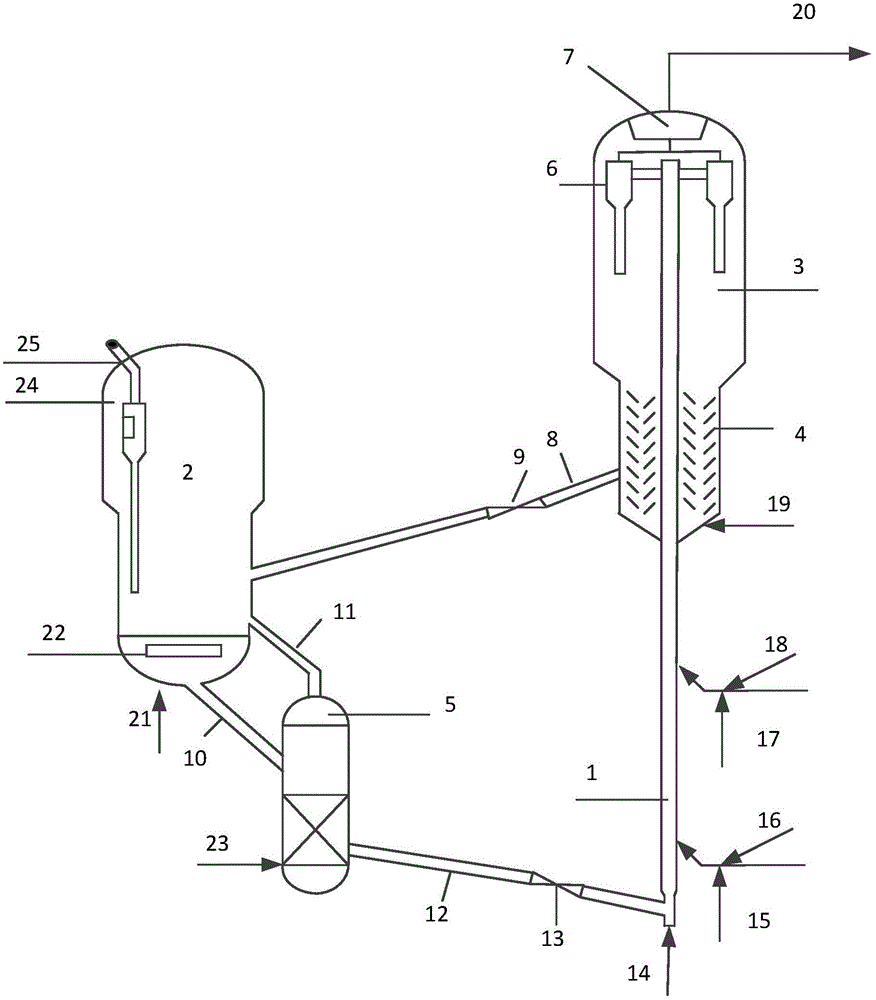Method for producing ethylene and propylene by catalytic cracking of lightweight petroleum hydrocarbons
A light petroleum hydrocarbon, catalytic cracking technology, applied in the field of light petroleum hydrocarbon catalytic cracking to produce ethylene and propylene, can solve the problems of low selectivity of target products, low yield of ethylene and propylene, low catalyst activity, etc., to achieve economical improvement Benefits and social benefits, the effect of increasing the cracking reaction speed and relieving huge pressure
- Summary
- Abstract
- Description
- Claims
- Application Information
AI Technical Summary
Problems solved by technology
Method used
Image
Examples
Embodiment approach
[0067] According to one embodiment of the present invention, when the method of the present invention is carried out in riser reactor, generally carry out as follows:
[0068] The regenerated catalyst rich in mesoporous zeolite (catalytic cracking catalyst) enters the pre-lift section of the riser reactor and flows upward under the action of the pre-lift medium. The preheated feedstock oil is mixed with carbon dioxide, and the mixture flow is together with atomized steam Inject into the lower part of the riser reactor, contact with the regenerated catalyst for catalytic cracking reaction and flow upward at the same time; the reacted stream enters the cyclone separator through the outlet of the riser reactor, and the separated reaction oil gas extraction device is further separated to obtain methane, ethylene and propylene , C4 hydrocarbons, pyrolysis gasoline and other fractions; the separated unborn catalyst enters the regenerator for coke regeneration, and the regenerated cat...
Embodiment 1
[0085] Carry out test according to the flow process of accompanying drawing, test on the medium-sized device of riser reactor, raw material oil is straight-run naphtha, and the raw material oil of preheating enters riser bottom after mixing with carbon dioxide (CO 2 The mass ratio to raw oil is 1:100), and the cracking reaction is carried out at a reaction temperature of 635°C, a reaction time of 2.0 seconds, a weight ratio of catalytic cracking catalyst to raw oil of 25, and a weight ratio of water vapor to raw oil of 0.3 , the reaction oil gas and water vapor and the raw catalyst enter the closed cyclone separator from the outlet of the reactor, the reaction oil gas and the raw catalyst are quickly separated, and the reaction oil gas is cut according to the distillation range in the separation system, so as to obtain methane, ethylene, propylene, mixed Fractions such as carbon four components and pyrolysis gasoline.
[0086] The raw catalyst enters the stripping section unde...
Embodiment 2
[0093] This embodiment is tested according to the flow process of accompanying drawing, and raw material oil is straight-run naphtha, and test is carried out on the medium-sized device of riser reactor, and the raw material oil of preheating and CO 2 After mixing, it enters the bottom of the riser (CO 2 The mass ratio to the raw oil is 1:100), and the cracking reaction is carried out under the conditions of a reaction temperature of 635°C, a reaction time of 2.0 seconds, a weight ratio of catalytic cracking catalyst to raw oil of 25, and a weight ratio of water vapor to raw oil of 0.3 , the reaction oil gas and water vapor and the raw catalyst enter the closed cyclone separator from the outlet of the reactor, the reaction oil gas and the raw catalyst are quickly separated, and the reaction oil gas is cut according to the distillation range in the separation system, so as to obtain methane, ethylene, propylene, mixed Fractions such as carbon four components and pyrolysis gasoli...
PUM
| Property | Measurement | Unit |
|---|---|---|
| pore size | aaaaa | aaaaa |
| pore size | aaaaa | aaaaa |
| pore size | aaaaa | aaaaa |
Abstract
Description
Claims
Application Information
 Login to View More
Login to View More - R&D
- Intellectual Property
- Life Sciences
- Materials
- Tech Scout
- Unparalleled Data Quality
- Higher Quality Content
- 60% Fewer Hallucinations
Browse by: Latest US Patents, China's latest patents, Technical Efficacy Thesaurus, Application Domain, Technology Topic, Popular Technical Reports.
© 2025 PatSnap. All rights reserved.Legal|Privacy policy|Modern Slavery Act Transparency Statement|Sitemap|About US| Contact US: help@patsnap.com

